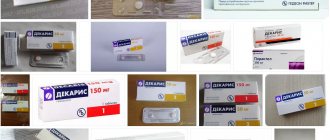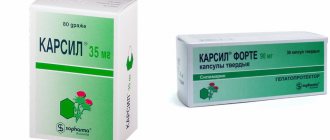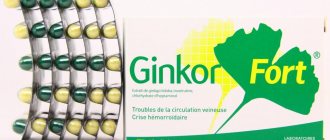Corvitol® 50 (Corvitol® 50)
Metoprolol is almost completely metabolized in the liver with the participation of isoenzymes of the cytochrome P450 system (mainly the CYP2D6 isoenzyme). Therefore, the concentration of metoprolol in the blood plasma may increase with the simultaneous use of substances that inhibit the CYP2D6 isoenzyme, and decrease with the simultaneous use of substances that induce the CYP2D6 isoenzyme. Caution should be exercised when using Corvitol® 50 simultaneously with inhibitors/inducers of the CYP2D6 isoenzyme.
Inhibitors of the CYP2D6 isoenzyme used in clinical practice include:
- antidepressants (for example, fluoxetine, paroxetine or bupropion);
- antipsychotic drugs (for example, thioridazine);
- antiarrhythmic drugs (for example, quinidine and propafenone);
- antiviral drugs (for example, ritonavir);
- antihistamines (for example, diphenhydramine);
- antimalarial drugs (for example, hydroxychloroquine or quinine);
- antifungal drugs (for example, terbinafine);
- H2 receptor blockers (for example, cimetidine).
When used simultaneously with these drugs, the effect of metoprolol may be enhanced.
Inducers of the CYP2D6 isoenzyme include:
- rifampicin;
- dexamethasone.
When used simultaneously with these drugs, the effect of metoprolol may be weakened.
Concomitant use with MAO inhibitors is contraindicated due to the possible enhancement of the antihypertensive effect. The treatment break between taking MAO inhibitors and metoprolol should be at least 14 days.
Simultaneous intravenous administration of verapamil can provoke cardiac arrest.
When coadministering CBCMs such as verapamil and diltiazem or other antiarrhythmic drugs (such as disopyramide), caution should be exercised and close monitoring for the development of hypotension, bradycardia or other arrhythmias.
With the simultaneous use of metoprolol and a BMCC such as nifedipine, a pronounced decrease in blood pressure and, in some cases, the development of heart failure are possible.
With the simultaneous use of metoprolol and antiarrhythmic drugs (for example, amiodarone), their action may be mutually enhanced.
Inhalation anesthetics (halogenated hydrocarbons) increase the risk of suppression of myocardial function and the development of arterial hypotension.
The simultaneous use of metoprolol with cardiac glycosides, reserpine, methyldopa, clonidine and guanfacine can lead to a decrease in heart rate and inhibition of AV conduction.
Agents that reduce catecholamine levels (for example, reserpine) may enhance the effect of beta-blockers, so patients taking such combinations of drugs should be regularly monitored by a physician to detect an excessive decrease in blood pressure or bradycardia.
If metoprolol and clonidine are taken simultaneously, then when metoprolol is discontinued, clonidine is discontinued after a few days (due to the risk of “slow” calcium channel syndrome, ethanol may lower blood pressure, special caution is required when used simultaneously with prazosin.
Allergens used for immunotherapy or allergen extracts for skin testing when used concomitantly with metoprolol increase the risk of systemic allergic reactions or anaphylaxis; iodine-containing radiocontrast agents for intravenous administration increase the risk of developing anaphylactic reactions.
Metoprolol reduces the clearance of xanthines (except for diprophylline), especially with the initially increased clearance of theophylline under the influence of smoking.
Metoprolol reduces the clearance of lidocaine and increases the concentration of lidocaine in the blood plasma.
Neuromuscular blockade caused by peripherally acting muscle relaxants (eg, suxamethonium or tubocurarine) may be enhanced by β-receptor blockade with metoprolol.
The simultaneous use of metoprolol and narcotic analgesics may cause an excessive decrease in blood pressure, and the negative inotropic effect of the above drugs may increase.
Cimetidine may enhance the effect of metoprolol.
Instructions for use CORVITOL
- antidepressants such as fluoxegine, paroxetine or bupropion;
- antipsychotic drugs such as thioridazine;
- antiarrhythmic drugs such as quinidine and propafenone;
- antiviral drugs such as ritonavir;
- antihistamines such as diphenhydramine);
- antimalarial drugs such as hydroxychloroquine or quinine;
- antifungal drugs such as terbinafine;
- H2 receptor blockers such as cimetidine.
- rifampicin;
- dexamethasone.
Known CYP2D6 inducers are:
When Corvitol® 50/100 is used together with insulin or other oral antidiabetic drugs, their effect may be enhanced or prolonged. Signs warning of hypoglycemia, in particular tachycardia and tremor, may be masked or suppressed. Therefore, regular checking of blood sugar levels is necessary.
An excessive decrease in blood pressure is possible with concomitant use of Corvitol® 50/100 and tricyclic antidepressants, barbiturates, phenothiazines and nitroglycerin, as well as diuretics, vasodilators and other drugs that lower blood pressure.
With the concomitant use of Corvitol® 50/100 and calcium antagonists such as nifedipine, an excessive drop in blood pressure and, in some cases, the development of heart failure are possible.
When used together, Corvitol® 50/100 and antiarrhythmic drugs may mutually enhance the effect.
When Corvitol® 50/100 is co-administered with calcium antagonists such as verapamil and diltiazem or other antiarrhythmic drugs (such as disopyramide), patients should be carefully monitored for the development of hypotension, bradycardia or other arrhythmias.
With concomitant use of Corvitol® 50/100 and cardiac glycosides, reserpine, alpha-methyldopa, guanfacine or clonidine, a more significant decrease in heart rate or cardiac conduction disturbance is possible. In case of abrupt withdrawal of clonidine with concomitant use of Corvitol® 50/100 and clonidine, an excessive increase in blood pressure may occur. Therefore, you can stop taking clonidine only a few days after you stop taking Corvitol® 50/100. The dose of clonidine can then be gradually reduced.
With the concomitant use of Corvitol® 50/100 and norepinephrine, epinephrine or other sympathomimetic substances (for example, contained in some cough medicines, nasal and eye drops), a significant increase in blood pressure is possible.
When treating allergic reactions with epinephrine, the response to epinephrine may decrease during therapy with Corvitol® 50/100.
Due to the possible development of excessive arterial hypertension, monoamine oxidase inhibitors (MAOIs) should not be used together with Corvitol® 50/100.
Indomethacin and rifampicin may weaken the effect of Corvitol® 50/100.
Cimetidine may enhance the effect of Corvitol® 50/100.
Corvitol® 50/100 may reduce the elimination of lidocaine.
The combined use of Corvitol® 50/100 and narcotic drugs may cause an excessive decrease in blood pressure. The negative inotropic effect of the above drugs may be additive.
Neuromuscular blockade caused by peripherally acting muscle relaxants (eg, suxamethonium or tubocurarine) can be enhanced by blocking beta receptors with Corvitol® 50/100.
If it is impossible to cancel the use of Corvitol® 50/100 before using general anesthesia or before using peripheral muscle relaxants, it is necessary to warn the anesthesiologist about treatment with Corvitol® 50/100.
Corvitol
Monitoring of patients taking beta-blockers includes monitoring heart rate and blood pressure (at the beginning of treatment - daily, then once every 3-4 months), blood glucose concentration in patients with diabetes (once every 4-5 months). The patient should be trained in the method of calculating heart rate and instructed about the need for medical consultation if the heart rate is less than 50/min.
It is possible that the severity of allergic reactions may increase (against the background of a burdened allergic history) and there will be no effect from the administration of usual doses of epinephrine.
In elderly patients, it is recommended to monitor kidney function (once every 4-5 months). May increase symptoms of peripheral arterial circulation disorders. Patients with cardiac arrhythmias whose systolic blood pressure is below 100 mm Hg should be given IV only if special precautions are taken (there is a risk of a further decrease in blood pressure). The drug is discontinued gradually, reducing the dose over 10 days.
In case of arterial hypertension, the effect occurs after 2-5 days, a stable effect is observed after 1-2 months.
For exertional angina, the selected dose of the drug should ensure the heart rate at rest within the range of 55-60 beats/min, and during exercise - no more than 110 beats/min. In smokers, the effectiveness of beta-blockers is lower.
In combination therapy with clonidine, the latter should be discontinued several days after metoprolol is discontinued in order to avoid a hypertensive crisis. At a dose above 200 mg/day, cardioselectivity decreases.
Metoprolol may mask some clinical manifestations of thyrotoxicosis (for example, tachycardia). Abrupt withdrawal in patients with thyrotoxicosis is contraindicated because it can increase symptoms.
In diabetes mellitus, it can mask tachycardia caused by hypoglycemia. Unlike non-selective beta-blockers, it practically does not enhance insulin-induced hypoglycemia and does not delay the restoration of blood glucose concentrations to normal levels.
If necessary, beta2-agonists are used as concomitant therapy for patients with bronchial asthma; for pheochromocytoma - alpha-blockers.
If surgical intervention is necessary, it is necessary to warn the anesthesiologist about the therapy being performed (choosing a drug for general anesthesia with minimal negative inotropic effect); discontinuation of the drug is not recommended.
Reciprocal activation of the n.vagus can be eliminated by intravenous administration of atropine (1-2 mg).
Drugs that reduce catecholamine reserves (for example, reserpine) can enhance the effect of beta-blockers, so patients taking such combinations of drugs should be under constant medical supervision to detect an excessive decrease in blood pressure or bradycardia.
If elderly patients develop increasing bradycardia (less than 50/min), arterial hypotension (systolic blood pressure below 100 mm Hg), AV block, bronchospasm, ventricular arrhythmias, severe liver and kidney dysfunction, it is necessary to reduce the dose or stop treatment . It is recommended to discontinue therapy if skin rashes appear and depression develops caused by taking beta-blockers.
The drug is discontinued gradually, reducing the dose over 10 days. If treatment is abruptly stopped, withdrawal syndrome may occur (increased angina attacks, increased blood pressure). When discontinuing the drug, special attention should be paid to patients with angina pectoris.
Patients who use contact lenses should take into account that during treatment with beta-blockers, the production of tear fluid may decrease.
During pregnancy, it is prescribed only for strict indications (due to the possible development of bradycardia, hypotension, hypoglycemia and respiratory paralysis in the newborn). Treatment must be interrupted 48-72 hours before delivery. In cases where this is not possible, it is necessary to ensure strict monitoring of newborns for 48-72 hours after delivery.
During the treatment period, care must be taken when driving vehicles and engaging in other potentially hazardous activities that require increased concentration and speed of psychomotor reactions.




